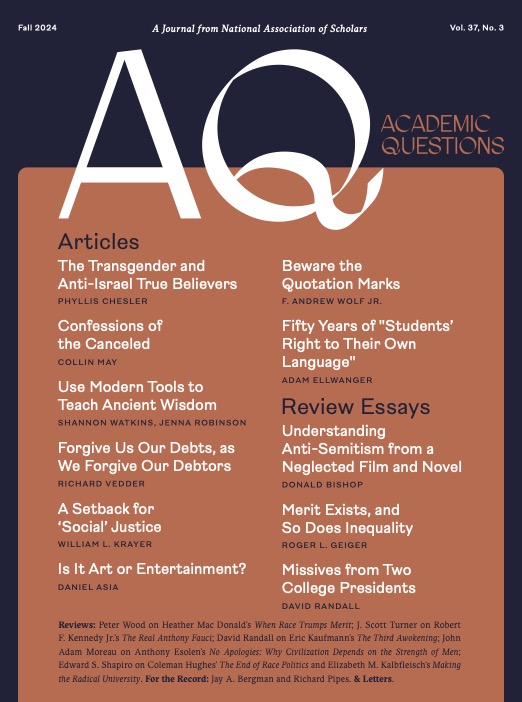Making the Radical University: Identity and Politics on the American College Campus, Elizabeth M. Kalbfleisch, University of Massachusetts Press, 2024, pp. xiv + 158, $99.00 hardcover, $27.50 paperback.
Everything has a history, and this includes the problems afflicting the modern American university. Elizabeth M. Kalbfleisch’s thin book traces these back, correctly in my opinion, to the 1960s with the emergence of the New Left, the black power movement, and modern feminism, as well as the rise to prominence of left-wing intellectuals such as Herbert Marcuse, C. Wright Mills, William Appleman Williams, and Alvin W. Gouldner. These movements and individuals influenced the zeitgeist of those who now, some six decades later, control the American university, particularly the most elite institutions, and are primarily responsible for its current difficulties.
That American higher education is now in a state of crisis is common knowledge. Harvard College experienced a five per cent decrease in applications for its freshman class of 2024, and the Gallup poll reported that between 2015 and 2023 the percentage of American adults who had confidence in higher education had declined from 57 percent to 36 percent. This figure has undoubtedly declined since then because of the protests and rioting taking place on campuses after the Hamas atrocities of October 7, 2023. As Andrew Gillen of the Cato Institute noted recently,
the same campus leaders who had spent years abandoning commitments to free speech in the name of safe spaces, trigger warnings, and microaggressions when it came to race and gender suddenly claimed to be free-speech stalwarts when the topic was the genocide of Jews…. A decade of hunting for dog whistles and launching bias-response teams left them with no room to plausibly play the free-speech card.1
These university administrators were simply mirroring the political orientation of their faculty which by the twenty-first century was overwhelmingly left-of-center. Today conservatively inclined scholars are more likely to be found in a think-tank than in a university.
Making the Radical University helps one understand how the American university arrived at this now unenviable situation. Each of its four chapters concerns a major aspect of campus culture of the latter half of the twentieth century: the controversy over broadening the academic curriculum; the impact of racial, gender, and political identity; the hullabaloo at Stanford University over required courses offered in Western civilization; and accusations of sexism and racism directed at the University of Texas (Austin).
Kalbfleisch is a professor of English at Southern Connecticut State University, and it is not surprising that each of these chapters focuses on the humanities, particularly English literature. This emphasis is apt because the responsibility for the current plight of the American university primarily rests with its humanities and social sciences departments and not with its science departments or professional schools.
Kalbfleisch sees the recent history of American culture through leftist lenses and sympathizes with those who, “deeply concerned with identity, representation, and radical Left activism,” advocated for curriculum reform from 1966 to 1991. Their effort was “noble, progressive, and on the right side of history,” and had a profoundly beneficial and transformative effect on American culture. It resulted in the recognition for a host of previously ignored people—“the poor and working class, women, the differently abled, homosexuals, and the non-binary.” (x, 2)
One of the books she discusses is Liberations: New Essays on the Humanities in Revolution, a 1971 collection of essays edited by Ihab Hassan, an English professor at the University of Wisconsin-Milwaukee. Kalbfleisch praises its contributors for their “radical, revolutionary spirit” (20) which challenged the regnant approach to the humanities. Among these was Bruce Franklin, a member of Stanford’s English Department who was dismissed from the faculty in 1972 for inciting students to riot. In a 1970 essay, “The Teaching of Literature in the Highest Academies of the Empire,” Franklin attacked those university scholars who valued the teaching of great literature at the expense of social and political action and were unfamiliar with Marx, Engels, Lenin, Mao, and Marxist criticism. Kalbfleisch uses the word “infamously” in describing Stanford’s firing of Franklin. A faculty committee found him guilty as charged, and a California state court sided with the university. Franklin was the only tenured Stanford professor ever to be fired.
Another incident Kalbfleisch discusses concerns Nathan Hare. Hare had been fired by Howard University in 1967 for attacking the university’s administration, supporting “black power,” inciting faculty-student protests, and inviting Muhammad Ali to speak on campus. He was then hired by San Francisco State University to head its Black Studies program which was established in 1968. Despite his Ph.D. in sociology from the University of Chicago, Hare was hardly an academic scholar, and his program’s course offerings sought to inculcate in its students a sense of black pride, revolutionary nationalism, and a determination to destroy white racism.
Instructive examples of Hare’s educational philosophy were two courses he added to the curriculum. One was Black Math (Black Studies 102). This, he wrote, focused on “presentation of mathematics as a way of thinking, a means of communication, and an instrument of problem solving, with special reference to the Black community” whereby “deductive, inductive, and heuristic methods of mathematics are developed and used with special attention to application to the Black community’s needs.” The other course was Black Science (Black Studies 104) which examined “the application of fundamental concepts and methods of science to the contributions of Black Americans.” When asked about the academic legitimacy of such courses, Hare responded that such a question was racist and implied that “any deviation on the part of Blacks away from white norms and standards would inevitably dip downward.” (24)
Hare’s stay at SFSU was short-lived. In 1969 he was fired from his position as head of the Black Studies Department and soon after dismissed from the faculty. Hare was somewhat of an academic quack, and Kalbfleisch’s failure to critique his academic approach reveals her own willingness to give the benefit of doubt to those seeking to discard academic standards in the service of remaking the American university.
Feminists, Kalbfleisch notes, were another influential and aggrieved group demanding changes in the academy. These involved the establishment of women’s studies programs, departments, and even colleges offering specialized courses in literature, history, philosophy, psychology, politics, and sociology which only women were deemed qualified to teach and would be closely tied to the politics of consciousness-raising, women’s liberation, and the obliteration of patriarchy. This emphasis by women and Blacks on group, rather than individual, entitlement led to demands by other aggrieved groups such as Native Americans, Hispanic Americans, Italian Americans, Irish Americans, Jewish Americans, and Polish Americans that their literature and history also deserved a place within the academic canon.
This was accompanied by the emergence during the 1970s of white ethnic studies as another area of study. This struggle among various victim groups for a piece of the academic pie simply mirrored what was occurring within society at large. Kalbfleisch quotes Mark M. Krug, a critic of white ethnic studies, who noted that leaders of the white ethnic studies movement had “lost a sense of proportion when speaking about the concept and role of ethnicity in American society.” (28) Left unstated is any acknowledgement by Kalbfleisch that the various attempts to broaden the college curriculum, if successful, would shrink the time devoted to teaching and reading the canonical works of Chaucer, Shakespeare, Milton, Austen, Byron, Dickens, Hawthorne, Whitman, Twain, and Melville, and that a literary version of Gresham’s law would inevitably result.
Kalbfleisch’s prime example of the attempt to change the American university occurred at Stanford University in March, 1988 when students and outsiders convinced the faculty senate to modify a required undergraduate general education course in Western civilization. In 1987 Stanford’s Black Student Union and African History Committee had urged the senate to eliminate “the unwarranted and unfounded glorification of one culture over another. Ultimately the Western culture program should become a program in North American Cultures and study the contributions and interrelationships between the cultures of Native Americans, Euro-Americans, Chicanos, Asian-Americans, and African-Americans." (79) The course as presently constituted, they claimed, reflected a Western-orientated mind-set heavily infused with racism and colonialism.
Raymond Giraud, a Stanford professor of French, seconded such thinking. The Western civilization course, he claimed, was rooted in a Judeo-Christian biblical outlook and the classical traditions of Greece and Rome. The problem arises from the fact that it requires “that this geographically centered, sexually centered, racially centered, class-centered, and even religiously-centered cultural package be imposed as our tradition in a society that claims to be color-blind, multi-racial, and sexually non-discriminatory.” (80; italics in the original)
Stanford's faculty senate decided that the course’s required reading list had to be revised since it only included works by European white male authors. Homer, Dante, and Darwin were to be replaced by non-European writers, and issues of race, class, and gender would be highlighted. This decision, Kalbfleisch notes, was part of a broader and beneficial nation-wide debate within the academy regarding the challenges presented by Marxists, deconstructionists, feminists, and other dissenters to the then reigning academic orthodoxy. One is struck in reading Kalbfleisch’s account by how little attention was paid by the Stanford faculty senate to intellectual distinction and the emergence of an academic spoils system in which being called Eurocentric was the ultimate insult. One disaffected Stanford professor accused his colleagues of “pandering to popular fads and campus revolutionaries” and “letting their supreme heritage largely go to the dogs.” (87)
Kalbfleisch’s other prime example of the influence of left-wing identity politics on the American college campus involves the University of Texas at Austin. In 1990 the university’s English department proposed using Paula Rothenberg’s Racism and Sexism: An Integrated Study (1987) as a textbook in ENG 306, a class in composition which was to be offered in the fall semester. Rothenberg, a professor of philosophy and women’s studies at William Paterson University in New Jersey, was a well-known Marxist and feminist scholar and supporter of virtually every major cause of the radical Left during the late twentieth century. The titles of some of her other books reflect this ideological orientation: White Privilege: Essential Readings on the Other Side of Racism; Invisible Privilege: A Memoir about Race, Class, and Gender; and Feminist Frameworks: Alternative Theoretical Accounts of the Relations between Women and Men.
Kalbfleisch does not discuss Rothenberg’s social and political views nor does she comment on whether her book was appropriate for a course in English composition. Protests appeared almost immediately when the choice to use Racism and Sexism was announced. One English professor at the university warned that the students in the course would have “their social attitudes as well as their essays graded by English Department instructors in what has to be the most massive effort at thought-control ever attempted on the campus.” (107) Other members of the department complained that the book reflected “a far-Left view with no countervailing opinion,” “portrays the United States as having completely failed women and people of color,” and asserts that “a Marxist class analysis of American society is essential for combating its evils.” (108-109) Faculty members who favored using Rothenberg’s book responded in kind, accusing critics of being right-wing extremists.
The controversy became so heated that the dean of the college of arts was forced to intervene. He decided in July, 1990, just six weeks before the fall semester was to begin, to postpone the teaching of ENG 306 for a year. A committee was appointed to come back with a plan which would mollify both the supporters and critics of Rothenberg’s text. Meanwhile the controversy went viral and was featured in the pages of the New York Times and the Chronicle of Higher Education. The committee was unable to come up with a proposal which satisfied everyone, and it disbanded in February, 1991 without issuing a final report. The controversy left a bad taste in the mouth of everyone involved, and the dean and three members of the English Department promptly resigned.
While enthusiastic about the objectives of the various radical academic reformers, Kalbfleisch is skeptical about the means that were often used to bring about the changes they sought. These included unfounded accusations of racism and “the conflation of education and activism, the supplantation of reason by emotion, ad hominem attacks, and the embrace of the idea that everything and anything is political.” (x) She also criticizes the academic Left for encouraging the “simplicity and dehumanization that lays the ground for the political polarization we live with.” (121)
Nevertheless, her opinion of the academic Left is largely positive. “Radicalized Leftist academics,” she concludes, “no doubt can be credited with many of the most positive social, political, and cultural developments of the last fifty years,” and she is confident that “the merit of the ultimate ends toward which the academic Left worked is, without doubt, great and unshakable.” (117)
The harm inflicted on the university by academic radicals, Kalbfleisch says, is simply “collateral damage” and is not inexorably linked with their overall goals. In fact, the intolerance and bullying which Kalbfleisch condemns is intrinsic and has occurred wherever and whenever the objective search for truth in teaching and research in the university has been subordinated to political and social goals. “If scholars do not advance the frontiers of knowledge within their disciplines, or if they betray the truth to satisfy other goals (such as accumulating wealth or advancing an ideology),” Greg Lukianoff and Jonathan Haidt wrote in The Coddling of the American Mind, “then they are not good scholars,” and the universities which employ them are not good universities.”2 Kalbfleisch’s volume briefly acknowledges but does not fully recognize the source or effects of this deformation of the university. At the very least, the veritable collapse of English and the other humanities as undergraduate majors—English majors have dropped by more than one-third since 2011 and history majors even more—should have been addressed in the context of the “great and unshakable” “ends toward which the academic Left worked.”
Unfortunately, the tendency within the academy to rationalize, ignore, and bend over backwards when confronting bullying and intimidation (“it all depends on the context”) has seeped down into other segments of American culture, including journalism. In April 2024 the Wall Street Journal reported on the problems at the New York Times caused by the refusal of some of its news staff to abide by traditional journalistic standards. Joe Kahn, the paper’s executive editor, observed, “Young adults who are coming up through the education system are less accustomed to … open debate, this sort of robust exchange of views around issues they feel strongly about than may have been the case in the past.”3
Things are not completely bleak, however. Public opinion and even college administrators have begun to wake up to the threat posed by DEI and the campus radicals. Thus Maggie Hicks titled her article in the April 15, 2024 issue of the Chronicle of Higher Education, “Dozens of Campuses Shed or Alter DEI Efforts as Political Pressure Mounts.” But, as Kalbfleisch’s book indicates, there is still a long way to go.
Edward S. Shapiro is professor emeritus of history at Seton Hall University; [email protected]. He is the author of A Time for Healing: American Jewry Since World War II (1992), Crown Heights: Blacks, Jews, and the 1991 Brooklyn Riot (2006), A Unique People in a Unique Land: Essays on American Jewish History (2022), and the editor of Letters of Sidney Hook: Democracy, Communism and the Cold War (1995). Shapiro last appeared in AQ with “Recalling the 1960s,” a review of Lauren Lassabe Shepherd’s Resistance from the Right (Summer 2024).
1 Andrew Gillen, “Saving Higher Education from Itself,” National Affairs, no. 59 (Spring, 2024), 45, 51.
2 Greg Lukianoff, Jonathan Haidt, The Coddling of the American Mind: How Good Intentions and Bad Ideas Are Setting Up a Generation for Failure (New York: Penguin Press, House, 2018), 254.
3Alexandra Bruell, “New York Times Faces Newsroom Rebellion,” Wall Street Journal, Saturday/Sunday, April 13-14, 2024, A11.
Photo by ruslee on Adobe Stock














